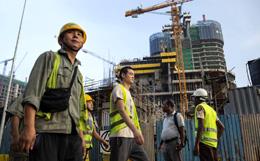Canada pension funds push investments in Asia

By Mata Press Service
The higher returns and rapid rates of economic growth in Asia’s emerging economies are driving Canadian pension funds’ investments in that region, states a new report from the Asia Pacific Foundation.
In 2023, Canadian pension funds held C$2.2T in capital, according to Statistics Canada. These funds are increasingly becoming more active investors in the Asia Pacific as they seek to benefit from the region’s rapid economic growth and demand for large, long-term infrastructure projects, said the report.
According to APF’s latest Investment Monitor data, which provides information on Canada-Asia Pacific investment flows into the region at the national and sub-national levels, pension fund investors accounted for around 50 percent of total Canadian investment flows into the region from 2019-2023.
Three Asia Pacific economies — Australia, China, and India — attracted around 76% of all Canadian pension funds’ investment flows into the region from 2003-23, the report said.
The Canadian Pension Fund Investments in the Asia Pacific report reveals that investment flows into the region from Canadian pension funds began growing in the 2010s and peaked in 2021 with C$22B invested in Asia Pacific economies that year, before dropping to C$8B and C$2.6B invested in 2022 and 2023, respectively.
At the national level, Australia has been the top recipient of Canadian pension fund investment flows, receiving 45 percent of the funds’ investment flows into this region between 2003 and 2018, and more than 50 percent of these flows from 2019-2023.
China was the second-largest recipient between 2003-2018, receiving 19 percent of total Canadian pension fund investment flows into the region, but from 2019-2023 has only received 3 percent of total investment flows. Canadian pension fund investment flows into China dropped to C$627M in 2020, and even further to C$423M in 2021, before ceasing in 2022.
From 2019 to 2023, India replaced China as the second-largest recipient of Canadian pension fund investment flows into the region, accounting for 25 percent of total investment flows, a significant increase from the 10 percent of investment flows the country received between 2003-2018. The top three sectors in India to receive investment flows from Canadian pension funds between 2013-2023 were real estate (comprising 57% of Canadian pension funds investment in India with over C$3.8B received), financial services (C$3B invested), and industrial transportation (roughly C$2.6B invested).
Here are the key highlights from the report;
· From 2003 to 2023, about 30% of all Canadian investment flows in the Asia Pacific were made by pension funds. These investment flows began growing in the early 2010s, peaked in 2021, at C$22B, then declined to around C$8B in 2022 and C$2.6B in 2023.
· Australia has been the region’s top recipient of Canadian pension fund investment flows; from 2003 to 2018, it accounted for 45% of these investment flows, with this percentage increasing to over 50% in 2019-23.
· Between 2003 and 2018, China was the second-largest recipient, accounting for 19% of Canadian pension fund investment flows in the Asia Pacific. Since then, however, this percentage has dropped to just 3% in the last five years (2019-23), with investment flows declining from C$627M in 2020 to C$423M in 2021. In 2022, all new Canadian pension fund investments in China ceased.
· As Canadian pension funds diversified away from China in the last five years, India has moved into second place, accounting for 25% of Canadian pension funds’ investment flows in the region from 2019 to 2023, up from 10% in the 2003-2018 period.
· From 2013 to 2023, about 57% of Canadian pension funds’ investment flows in India were in real estate (more than C$3.8B), financial services (more than C$3B), and industrial transportation (around C$2.6B). The infrastructure and renewable energy sectors are becoming especially attractive for investors, as India’s governments’ national and regional plans and policies support their expansion.
· Although Canada-India bilateral tensions worsened in September 2023, Canadian pension fund investment flows into India actually increased from C$28M in the third quarter of 2023 to C$111M in the fourth quarter of 2023, driven by a large investment in Xpressbees by the Ontario Teachers’ Pension Plan Board. Nevertheless, the longer-term effects of bilateral tensions on two-way investment remain to be seen. Pension funds take a long-term view on their investments, which may dampen the impact of the current political tensions.
The report said emerging and developing economies in Asia, are projected to grow at around 5.2% in 2024 and 4.8% in 2025. Three of these economies — India, the Philippines, and Vietnam — are expected to grow at around 6% over the next five years.
Infrastructure, considered to be a stable and low-risk asset, is one sector in Asia for which there is a growing appetite for investment. Parts of the region are facing a substantial infrastructure gap of C$596B per year (excluding social infrastructure), with developing economies requiring up to C$2.3T in investment per year to maintain their current growth trajectories, combat poverty, and mitigate the effects of climate change.
The region’s various net-zero pledges, just energy transition partnerships, and shift to renewable energy generation could also present foreign investors with substantial opportunities for infrastructure investment.
The report anticipates that Canadian pension funds will expand their presence, in the Asia Pacific and that their expanded presence will align with the aims of the Canada痴 Indo-Pacific Strategy.






